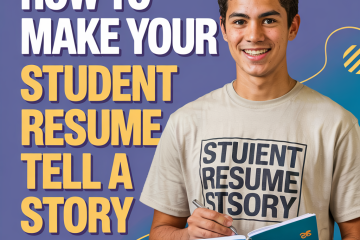“I Have No Work Experience!” – Building a Resume That Highlights Skills & Projects

Staring at a blank resume and thinking, “I have no work experience!”? Many students feel this way when creating their first resume. But don’t worry! You have more to offer than you think. This guide shows you how to build a strong resume by highlighting your skills, academic projects, extracurricular activities, and volunteer work. Let’s turn that “no experience” into a “skill-rich” resume! To further showcase your unique strengths and achievements, consider building a comprehensive digital profile on platforms like Cirkled in, where you can visually represent your accomplishments beyond the traditional resume format.

The “No Experience” Resume Myth
The idea that you need paid work experience to have a good resume is a myth. Colleges and organizations want to see skills, commitment, and a willingness to learn. You’ve gained these qualities through school, hobbies, and activities. Your resume is a chance to show them off! In addition to a traditional resume, you can also leverage Cirkled in to build a portfolio of your work, making your application even more compelling.
Skills First: What You Do Have
Think about the skills you’ve developed. List both “hard skills” (like coding, writing, or data analysis) and “soft skills” (like teamwork, communication, or problem-solving). Where did you gain these skills? Here are some ideas:
- Classes: Did you excel in math, science, or English? List relevant skills.
- Hobbies: Do you play video games? Mention problem-solving or strategy.
- Everyday Life: Can you manage your time well? That’s a valuable skill!
“Communication skills: Developed through leading group projects and presenting research findings.” You can even add visual evidence of these skills to your profile on Cirkled in, making your claims more impactful.
Academic Projects: Showcasing What You’ve Learned
Think about projects where you shone. Did you create a website for a class? Write a research paper? Build a robot? These projects demonstrate your ability to apply knowledge and achieve results.
- Project Name: (e.g., Website Design for History Class)
- Brief Description: (e.g., Designed and built a website showcasing historical events.)
- Skills Used: (e.g., Web design, coding, research, communication.)
Extracurricular Activities: More Than Just Fun
Your clubs, sports, and other activities show your interests and commitment. Even if they don’t seem directly related to your career goals, they demonstrate valuable skills like teamwork, leadership, and time management.
- Activity: (e.g., Debate Club)
- Role: (e.g., President)
- Responsibilities: (e.g., Organized meetings, led debates, recruited new members.)
- Skills Gained: (e.g., Public speaking, leadership, organization, critical thinking.)
Volunteer Work: Making a Difference (and a Resume)
Volunteering shows you care about your community and are willing to help others. It also provides opportunities to develop new skills and gain valuable experience.
- Organization: (e.g., Local Food Bank)
- Role: (e.g., Volunteer)
- Responsibilities: (e.g., Sorted donations, assisted with food distribution, assisted clients.)
- Skills Gained: (e.g., Teamwork, communication, customer service, organization.)
The STAR Method: Telling Your Story
Use the STAR method (Situation, Task, Action, Result) to describe your experiences. This helps you provide concrete examples of your skills and accomplishments.
- Situation: Describe the situation or context.
- Task: Explain what you were tasked with doing.
- Action: Detail the actions you took to complete the task.
- Result: Highlight the positive outcome or result of your actions.
Example: “Led a fundraising campaign for the school’s Science Club (Situation). I was tasked with raising $500 for a science fair trip (Task). I organized bake sales, car washes, and donation drives (Action). We raised $600, exceeding our goal and enabling the entire club to attend the science fair (Result).”
Resume Template & Formatting Tips for First-Timers
- Choose a clean and easy-to-read template. Many free templates are available online.
- Use a professional font like Arial or Times New Roman.
- Keep it concise. Aim for one page.
- Proofread carefully! Ask a friend or family member to review it.
- Sections: Include sections for Skills, Education, Projects, Activities, and Volunteer Work.
- Contact Information: Make sure your email and phone number are correct.
Conclusion: Resume With No Experience? Highlight Skills & Projects!
Having “no work experience” doesn’t mean you have nothing to offer. By highlighting your skills, projects, activities, and volunteer work, you can create a compelling resume that showcases your potential. Remember to use the STAR method to tell your story and choose a clean, professional template. To further showcase your achievements and build a dynamic portfolio, consider creating a profile on platforms like Cirkled in, where you can visually represent your skills and projects beyond the traditional resume format. Good luck! You’ve got this!
Need more tips on college applications, scholarships, or just how to survive this whole process? Cirkled In has your back—check out Cirkled In resources to help you through every step of your college journey!



0 Comments